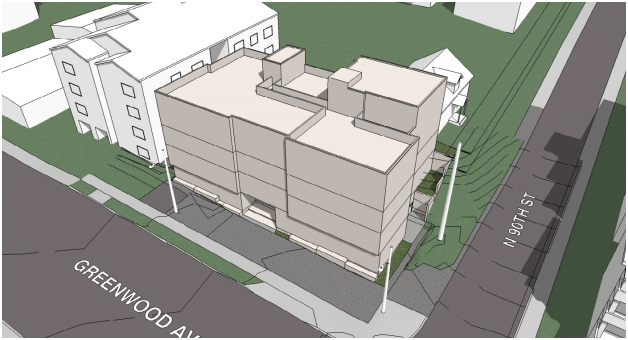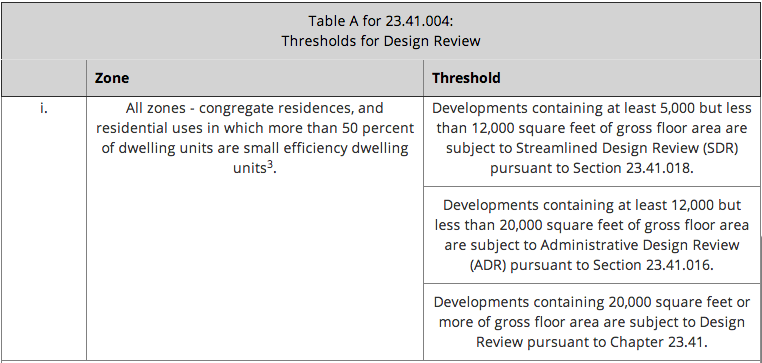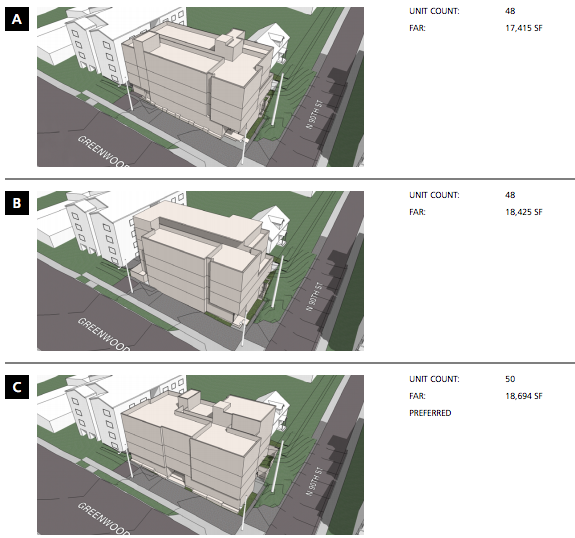
Seattle’s Design Review Program has a lot of upcoming meetings for new projects in the New Year, but one in particular has caught our attention. Meet 9002 Greenwood Ave N, a brand new four-story, 48-unit microhousing development in Greenwood. As far as we know, this is the first microhousing project to proceed through design review under the new microhousing rules. But before we get to the details of this project, we want to bring you up to speed on the new microhousing code.
A Bit of Background
Way back in October, the City Council adopted an ordinance to specifically regulate microhousing developments in the city. The adoption of new rules was in response to significant, longstanding concern amongst community groups, activists, and residents about microhousing and congregate housing projects. Previously, these developments were subject to the same rules that applied to all congregate housing developments like dormitories and senior housing. Projects would often proceed as townhouses by proposing maximum ratios of bedrooms to shared kitchen and bathroom facilities. The City responded with a new set of rules to treat micorhousing and congregate housing differently in three key ways: separate definitions and intent, zoning district-specific rules, and the rigor of review by project scale.
Separate definition and intent. Microhousing and congregate housing are now clarified in the code as separate uses. In essence, microhousing are differentiated by the character of the living arrangement. Microhousing is geared toward independent living of residents in “small efficiency dwelling units”. Units required to be a minimum size of 220 square feet and contain a full kitchen. Previously, groups of eight sleeping rooms with a shared kitchen were permissible. Meanwhile, congregate housing is now geared more toward the elderly, infirmed, disabled, and students. Unlike small efficiency dwelling units, the Land Use Code explicitly discourages private kitchens and places no minimum size on units in congregate housing living arrangements.
Zone district-specific rules. Microhousing is effectively restricted to zones that permit multifamily dwelling uses like mixed use zones, commercial zones, and lowrise and midrise residential zones. Private congregate housing developments, however, are further restricted to only Urban Villages and Urban Centers with high density zoning types like Neighborhood Commercial 3, Midrise Multifamily, and Downtown zones. Although, exceptions are granted when congregate housing developments are owned by or affiliated with colleges, social welfare providers, and licensed support services.
Project review by scale. Most new microhousing and congregate housing projects are subject to some form of design review. As you can see in the table below, the entry threshold for design review begins at 5,000 square feet of gross floor area. This is basically the total square footage of a building. In the instance of the Greenwood project, the gross floor area is anticipated to be between 17,415 square feet and 18,694 square feet. Therefore, the project is subject Administrative Design Review, a type of design review that is geared toward a shorter process of public and neighborhood feedback on priority design issues.

Greenwood Project
The Greenwood microhousing will be located at the corner of Greenwood Ave N and N 90th St. The area is currently zoned as C1-40, a commecial/mixed use zone with a maximum height of 40 feet. The applicant is proposing a four-story apartment building, which meets the 40-foot maximum for the zone. At least 48 units will be provided, but the applicant is exploring an option to maximize the site with 50 units. Project amenities include a rooftop deck with green space, some private patios, and bike storage on the ground floor.
The site does present some challenges given that the eastern portion is steeply sloped. To address this, the applicant plans to retain the building into the sloped hillside. As you can see in the massing comparisons below, two structures are immediately adjacent to the site. On the north, there is a four-story apartment building while on the east there is a single-story single-family residence (which is also zoned C1-40). Despite how close the single-family residence may appear to the proposed structure, the applicant plans to maintain at least a 7-foot setback from the east property line.

The applicant is proposing three different massing options* for the new microhousing building (as seen above). To illustrate these, the applicant analyzed each option in detail through their design review submittal materials. I’ll provide some broad comparisons between the options based upon that as follows:
- Options A and B would have 48 units while Option C (the applicant’s preferred option) would have 50 units.
- Options A and C would have the most continuous frontage on Greenwood Ave N.
- Options A and B would accentuate the corner by projecting it toward the street.
- Option C would modulate the primary facade, but would leave overhanging facades on the north and south sides.
- Options A and B would have corner entries while Option B would have an entry toward the center on Greenwood Ave N.
- Option B would stepback the fourth floor from the south side.
- Options A and C would have the most opportunity for landscaping along Greenwood Ave N frontage.
These are just a few of the comparisons that can be made between the options. But the issues of the project proposal could of course expand far beyond the scope of just these details. I do want to bring up one issue worth mentioning: frontage setbacks. Urbanists are often concerned with how much a building is setback, and in this instance the streets and sidewalk present an odd circumstance.
This project proposal consists of deep setbacks along both street frontages. Neither of these are exactly by the applicant’s choosing. The frontage of Greenwood Ave N has a very wide public right-of-way (90 feet to be exact). The applicant’s proposed layout would in effect have the apartment built right up to edge of the Greenwood right-of-way–even though the sidewalk does not begin for another 15 feet from that point.
How to Get Involved
If you’re interested in attending the community design review meeting, you can do so next week. The Northeast Design Review Board will convene its meeting at the Ballard Community Center located at 6020 28th Ave NW. The meeting starts promptly at 6.30pm and begins with a presentation by the applicant, followed by Q&A from Board, and ultimately an opportunity for public comment.
Alternatively, you can submit comments on the project to the project planner, Lindsay King. Should you choose to comment via e-mail, please ensure that you do so before Monday if you would like Lindsay to incorporate your comments into the Design Review Board packets. It is helpful to quote the project number (3018316 in this case), and comments should be carbon copied to PRC@seattle.gov. In order to be most effective, comment on issues that fall under the citywide and Greenwood/Phinney design review guidelines.
*It should be noted that these are the preliminary massings of the proposed structure. Further refinement of materials, architectural features, and layout modifications will be made in response to comments and feedback at a later stage.
Stephen is a professional urban planner in Puget Sound with a passion for sustainable, livable, and diverse cities. He is especially interested in how policies, regulations, and programs can promote positive outcomes for communities. With stints in great cities like Bellingham and Cork, Stephen currently lives in Seattle. He primarily covers land use and transportation issues and has been with The Urbanist since 2014.



